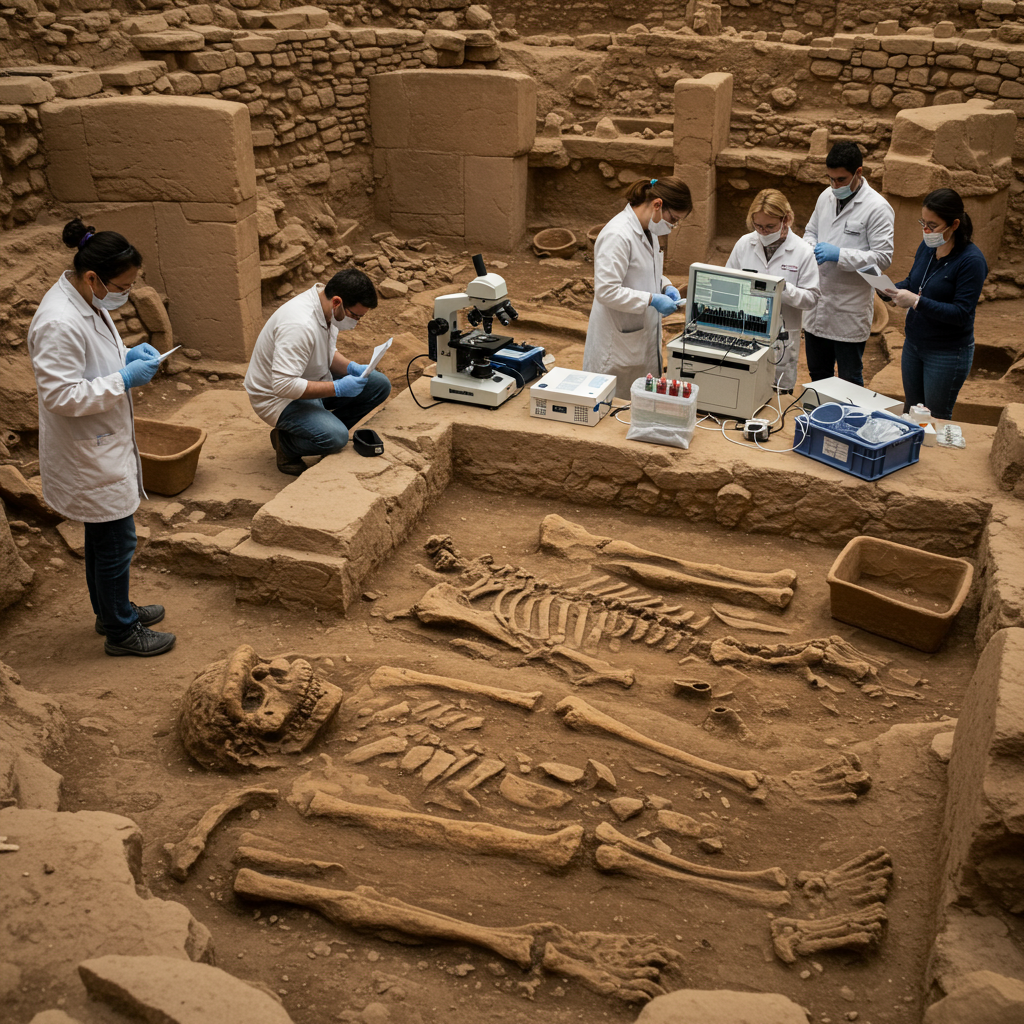Groundbreaking genetic research from the 9,000-year-old proto-city of Çatalhöyük in Turkey has finally provided concrete evidence about its social structure. For decades, archaeologists have debated whether this massive Neolithic settlement was egalitarian or held a distinct power dynamic. New ancient DNA analysis of burials beneath its famous mud-brick houses reveals that this early agricultural community was likely structured around maternal lineages, identifying it as the oldest genetically-confirmed “female-centered” society of its kind in food-producing cultures.
This discovery, published in the journal Science, significantly advances our understanding of social organization in the crucial period when humans transitioned from foraging to farming. It directly challenges previous assumptions and offers a rare glimpse into the complex kinship ties of one of the world’s earliest large settlements. The findings suggest that female lines played a pivotal role in defining household connections and potentially social structure.
Unearthing Clues at Çatalhöyük
Located in south-central Turkey, Çatalhöyük was a vast settlement. It spanned over 32.5 acres (13.2 hectares). The site was continuously occupied for nearly a millennium, from around 7100 B.C. It is renowned for its unique architecture. Residents entered their homes through roofs using ladders. Burials often occurred directly beneath the floors of these houses.
The site is also famous for its rich symbolism. This includes elaborate wall murals. A diverse array of female figurines have also been found here. These figurines sparked early interpretations of the site’s social structure.
Decades of Debate
When archaeologist James Mellaart first excavated Çatalhöyük in the 1960s, he was struck by the numerous female figurines. He interpreted them as evidence. Mellaart believed the society was matriarchal. He proposed they practiced “mother goddess” worship. This, he speculated, might have been linked to ensuring good harvests. This was a vital concern. The community was undergoing a major shift. They were transitioning from hunting and gathering to cereal-based agriculture.
However, when Stanford archaeologist Ian Hodder took over excavations in the 1990s, his research offered a different view. Hodder suggested Çatalhöyük was largely egalitarian. He found little evidence of significant social or economic differences. These differences might typically distinguish men and women in hierarchical societies. This created a long-standing question about the site’s true social makeup.
DNA Unlocks Ancient Secrets
To finally address this long-standing debate, a team of researchers, including evolutionary geneticist Mehmet Somel and archaeologist Ian Hodder, turned to ancient DNA technology. They analyzed DNA extracted from 131 skeletons. These remains were dated to between 7100 and 5800 B.C. The skeletons were discovered buried beneath the floors of houses at Çatalhöyük.
The research team successfully connected 109 individuals genetically. These people were buried across 31 different buildings. The analysis revealed a clear pattern in burial locations based on kinship. All first-degree relatives—parents, children, and siblings—were consistently buried together. They shared the same building. Second-degree relatives, such as uncles, aunts, nephews, nieces, and grandparents, were often buried differently. They were found in nearby buildings. Third-degree relatives, like first cousins and great grandparents, also tended to be buried close by. This kinship pattern strongly suggested something important. Nuclear or extended families played a fundamental role. They structured the households at Çatalhöyük.
The “Female-Centered” Pattern Emerges
While studying the intergenerational connections within the house burials, the researchers noted a striking trend. The primary basis for these connections appeared to be maternal lineages. This finding was unexpected.
“We weren’t particularly looking for these maternal connections within buildings,” study co-author Mehmet Somel told Live Science. However, the evidence was clear. It demonstrates that male-centered practices were not universal. Such practices have often been documented. They are seen in Neolithic and Bronze Age Europe.
Ancient DNA analysis offered another advantage. It allowed researchers to determine the biological sex of infants and young children. This is typically impossible using skeletons alone before puberty. With this information, the team identified a female-linked trend in grave goods. “The pattern of more burial gifts for female babies was also not something we were expecting,” Somel noted. This suggests a potential preference or significance associated with female infants within the community’s burial practices.
Significance and Comparisons
Çatalhöyük now stands out as a unique site. It is the oldest society discovered. DNA evidence has revealed this type of female-centered social organization. Jens Notroff, an archaeologist not involved in the research, highlighted the significance. “To my knowledge,” he said, “this constitutes the first systematic evidence of such a continuously matrilineally organised Neolithic community.”
The researchers chose the term “female-centered.” They used it instead of “matrilineal.” Somel explained this choice. “We preferred using ‘female-centered’ instead of matrilineal because the latter is about how people define kin,” he stated. “Çatalhöyük households could have been matrilineal, but we think using more general terms might be preferable. It is always good to be cautious.”
However, archaeologist Benjamin Arbuckle offered a different perspective in Science. He suggested scholarly hesitation in labeling it “matriarchal” or even strongly “matrilineal” might stem from bias. Arbuckle argues, “if the sex patterns were reversed, there would likely be little hesitation in concluding that patriarchal power structures were at play.” He added that scholars often struggle to imagine societies with substantial female power. This is despite significant archaeological and ethnographic evidence.
Contrasts and Other Findings
The findings at Çatalhöyük contrast sharply with the patrilineal patterns. These patterns are commonly observed in later Neolithic Europe. This raises intriguing questions. When, how, and why did such a fundamental shift in social organization occur?
Interestingly, ancient DNA analysis is increasingly revealing diverse social structures in the deep past. For instance, a recent study on 4,500-year-old skeletons in Stone Age China also found evidence suggesting a society structured around maternal lineages. This community appears to have maintained this structure for at least 10 generations. Another study on ancient Irish burials, while complex, shows how DNA is challenging previous assumptions about social hierarchy and kinship in other Neolithic European contexts. These examples highlight the power of ancient DNA. It helps archaeologists move beyond interpretations based solely on artifacts or architecture.
Analyzing skeletons from Çatalhöyük is just the beginning, according to Somel. A crucial next step is determining if this site is unique. “We are now producing similar data from earlier societies from the region,” he said. This research aims to provide answers soon. It will help paint a clearer picture of prehistoric social evolution in the Near East.
Frequently Asked Questions
What does “female-centered society” mean at Çatalhöyük?
In the context of the Çatalhöyük study, “female-centered” refers to evidence from ancient DNA analysis suggesting that maternal lineages (inherited through mothers) were central to how households were structured and how people were buried together over generations. While the researchers use this term cautiously, it indicates that female lines played a primary role in kinship and household organization, in contrast to male-centered or patrilineal systems found elsewhere. It doesn’t necessarily imply a society ruled politically by women (matriarchy), but rather a social structure where identity and connection were traced primarily through mothers.
Where was the ancient proto-city of Çatalhöyük located and when did it exist?
Çatalhöyük is located in south-central Turkey, near the modern city of Konya. It is an important archaeological site from the Neolithic period. The settlement was inhabited continuously from approximately 7100 B.C. to 5800 B.C. For about 1,000 years, it was a large, thriving community. It is considered one of the earliest examples of a large proto-city. Its size and complexity were unusual for its time.
How does the Çatalhöyük finding compare to other ancient societies studied with DNA?
The discovery at Çatalhöyük is significant because the DNA evidence showing a female-centered kinship pattern is the oldest of its kind found in food-producing societies. This contrasts with the predominantly patrilineal patterns seen later in Neolithic and Bronze Age Europe. While evidence for similar maternal lineages has been found using ancient DNA in other, slightly later contexts (like Stone Age China or some European Iron Age groups), Çatalhöyük provides key insights into early social organization during the dawn of agriculture in the Near East. It shows that diverse social structures existed early in human history.
The DNA analysis from Çatalhöyük offers compelling new evidence. It supports the idea of a social structure. This structure was distinct from purely egalitarian or strictly patriarchal models. The focus on maternal lineages provides a fresh perspective. It sheds light on the complex lives of people. These people lived in one of the world’s earliest cities. This research underscores the power of genetics in illuminating the social dynamics of the distant past. Future studies at other sites promise even more insights. They will help us understand the diverse ways human societies organized themselves.




